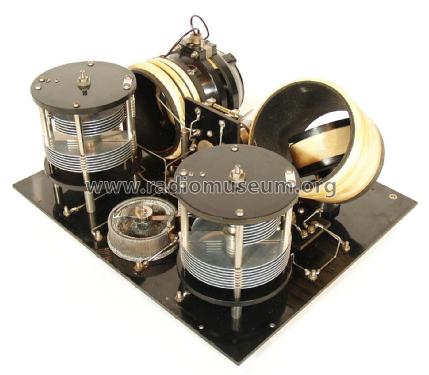Intermediate Wave Receiver Type 220 1st Version
Kennedy Co., Colin B.; San Francisco & St.Louis
- Country
- United States of America (USA)
- Manufacturer / Brand
- Kennedy Co., Colin B.; San Francisco & St.Louis
- Year
- 1921
- Category
- Broadcast Receiver - or past WW2 Tuner
- Radiomuseum.org ID
- 286964
-
- alternative name: Colin B. Kennedy Corp.
- Brand: Globe Trotter
- Number of Tubes
- 1
- Valves / Tubes
- UV200
- Main principle
- TRF with regeneration
- Wave bands
- Broadcast (MW) and Long Wave.
- Power type and voltage
- Storage and/or dry batteries
- Loudspeaker
- - For headphones or amp.
- Material
- Wooden case
- from Radiomuseum.org
- Model: Intermediate Wave Receiver Type 220 [1st Version] - Kennedy Co., Colin B.; San
- Shape
- Tablemodel, Box - most often with Lid (NOT slant panel).
- Dimensions (WHD)
- 370 x 320 x 230 mm / 14.6 x 12.6 x 9.1 inch
- Notes
-
From the Western Historic Radio Museum:
The Kennedy Intermediate Wave Receiver was introduced in 1921. Its appearance is similar to the earlier SWR-6 but that receiver tuned the Short Waves. It is also similar its immediate predecessor, the Type 200 (though the Type 200s tuning range is also usually specified as Short Wave.) The Type 220 was built to the same high quality as the Universal Receiver but the tuning range was from 150 meters up to 3000 meters, or about 2000kc down to 100kc. This is a good portion of the Medium Wave and Low Frequency part of the spectrum, so the Type 220 was designated as an Intermediate Wave Receiver. The Type 220 circuitry is essentially the same as the Universal with adjustments made to the coil and condenser size due to the receiver's reduced tuning range. One readily visible difference is the mounting of the inductance switches in which the contacts and arms are fully exposed with front panel mountings. The Primary Inductance switch has nine positions for tuning the antenna and a Series-Parallel switch was included to select whether the Primary Condenser was connected as a series LC or a parallel LC. The Secondary Inductance switch has four positions that select tuning ranges with the highest frequency range selected by rotating the knob fully CCW. The ranges approximately tune 2000kc to 800kc for Band one, the highest frequency position. Band two covers 1000kc to 500kc, band three covers 600kc to 300kc and band four covers 300kc down to 100kc.
The Type 220 Coupling and Regeneration controls use matte silver-plated dials and the Filament control uses a knob with no scale. There was no "fine tuning" adjustment knob on the Secondary condenser on the early models, however, later versions of the Type 220 will have this feature. Sometimes an extra filament potentiometer will have been installed to allow the use of a UV-200A tube with .25A filament. This modification was usually a dealer addition if the work was of professional quality. A filament voltmeter was not used in the Type 220.
The Type 220 went through the same evolution as the Universal so early versions, made in San Francisco, will have nickel-plated binding posts and a Plate Potentiometer control while the later St. Louis versions have bakelite capped binding posts and no Plate adjustment. Most Type 220 coils are coated in clear shellac giving the coils a white appearance while most Type 110 receiver coils were coated with amber shellac. While most components aren't interchangeable, the same quality and style of manufacture is used in the Type 220 as with the other 1921-22 Kennedy equipment.
- Net weight (2.2 lb = 1 kg)
- 8.3 kg / 18 lb 4.5 oz (18.282 lb)
- Price in first year of sale
- 125.00 $
- Mentioned in
- -- Original prospect or advert (October, 1921 Radio News magazine)
- Literature/Schematics (1)
- Radio Manufacturers of the 1920's, Vol. 2 (page 93)
- Author
- Model page created by Alan Larsen. See "Data change" for further contributors.
- Other Models
-
Here you find 145 models, 76 with images and 67 with schematics for wireless sets etc. In French: TSF for Télégraphie sans fil.
All listed radios etc. from Kennedy Co., Colin B.; San Francisco & St.Louis
Collections
The model Intermediate Wave Receiver is part of the collections of the following members.
Museums
The model Intermediate Wave Receiver can be seen in the following museums.











